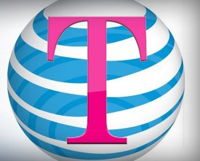AT&T buys T-mobile to create the new top dog in US wireless

On Sunday, Deutsche Telekom agreed to sell its T-Mobile USA property to AT&T to help AT&T create America's largest mobile phone provider, trumping Verizon Wireless. The deal involves cash and stock and is currently valued at $39 billion.
The move also has larger global implications as Deutsche Telekom establishes a relationship with AT&T that makes the US provider a part of its global family of wireless carriers -- similar to how Verizon is connected to Vodafone. How's will work? Deutsche Telekom gets an executive seat on the AT&T board of directors and becomes a major shareholder in the company.

On the other hand, both AT&T and T-Mobile have similar GSM networks. Their 3G networks are based on different frequencies but both companies have been building faster networks based on HSPA+ so we should really look at this as a 4G move. The two companies have been badly trailing Verizon Wireless in 4G now that Verizon has aggressively begun rolling out LTE across the US. While HSPA+ isn't as fast or as robust as LTE, the combined HSPA+ networks of AT&T and T-Mobile will give them a larger footprint than Verizon's current LTE network.
Of course, integration still takes time - even for compatible networks. CNET's Maggie Reardon perfectly sums up the 4G challenges that lie ahead for AT&T in integrating T-Mobile (if the deal gets regulatory approval):
While it's true that T-Mobile and AT&T each use GSM technology, the carriers also use different bands of spectrum to deliver their services. Specifically, T-Mobile uses the spectrum it bought in the AWS spectrum auction in 2006 to build its 3G wireless network. AT&T also acquired spectrum in that auction. And it is using this AWS spectrum to build its LTE network. AT&T uses its 850MHz and 1900MHz spectrum to deliver its 3G service. Part of the reason that AT&T wanted T-Mobile in the first place was to get more of the AWS spectrum for its LTE network. Meanwhile, T-Mobile has no additional spectrum to deploy LTE, since it's been using the AWS spectrum for its 3G service. What this means is that once AT&T and T-Mobile merge, AT&T will have to move all of T-Mobile's existing 3G customers (which includes the supposed 4G HSPA+ customers) to AT&T's 850MHz and 1900MHz spectrum. This means T-Mobile customers will need new handsets, since the existing T-Mobile 3G HSPA and 4G HSPA+ handsets will no longer work on the AWS spectrum.
Meanwhile, Verizon is planning to upgrade its entire nationwide network to LTE by the end of 2013. This unexpected AT&T/T-Mobile tie-up could have the effect of accelerating the 4G race in the US, which would make the American 4G networks some of the best on the planet -- a reversal of fortune after the US fell behind Europe and Asia in 3G.
Note: We're likely to hear more about the AT&T/T-Mobile merger and its potential implications this week at the CTIA Wireless conference on Orlando. I'll be there covering it from beginning to end. You can read my posts here as well as follow me on Twitter for the latest updates from the conference.
Read more
- AT&T to Acquire T-Mobile USA from Deutsche Telekom (AT&T)
- Q&A: More Information About AT&T Acquisition of T-Mobile USA (T-Mobile)
- AT&T Buying T-Mobile USA In $39 Billion Deal (Silicon Alley Insider)
- AT&T to Buy Deutsche Telekom T-Mobile Unit for $39 Billion in Cash, Stock (Bloomberg)
- Why AT&T Bought T-Mobile (Mashable)
- Can Sprint win over regulators in AT&T, T-Mobile merger? (ZDNet)
- AT&T-T-Mobile USA deal may face regulatory hurdles (CNET)
- AT&T-T-Mobile merger: By the numbers (CNET)